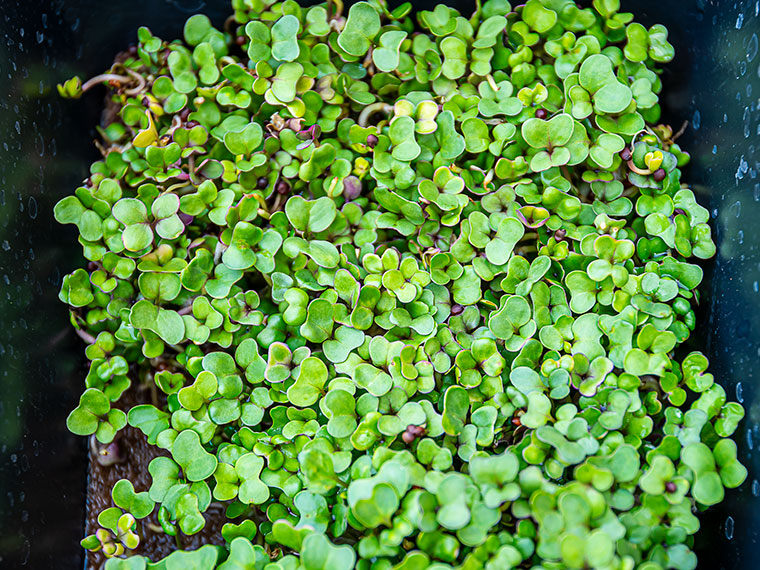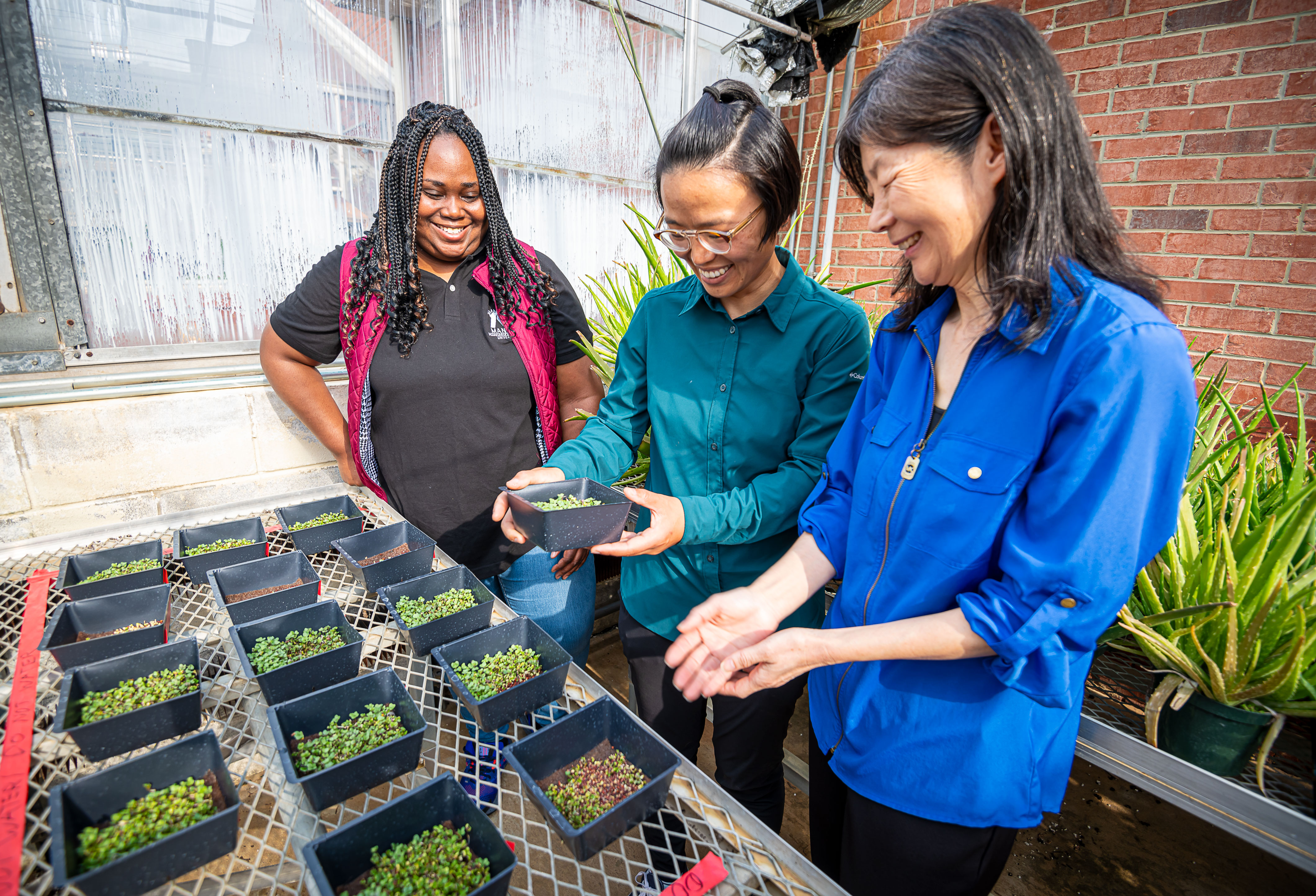The information presented on this page may be dated. It may refer to situations which have changed or people who are no longer affiliated with the university. It is archived as part of Mississippi State University's history.
Culinary tastes change over time and oftentimes innovation spurs those changes. From cabbage to iceberg to romaine and now microgreens, our salad plate has changed. Cabbage was the salad of the 19th century because it stayed fresh and crisp longer than lettuce. Iceberg revolutionized salad at the turn of the 20th century because it could be grown in hot weather shifting salad from seasonal treat to culinary staple. In the latter part of the 20th century, development of the grocery store's cold chain made more varieties like romaine available in the U.S. Now in the age of nutritional optimization, smart water and superfoods, microgreens young seedlings dense in nutrients are all the rage.
The U.S. microgreen industry is estimated at 1.74 billion in 2024 and is expected to reach 2.86 billion by 2029, according to www.researchandmarkets.com. Microgreens are a great add on for vegetable farmers looking to diversify and a good starter crop for farmers just getting into produce because they can be grown in small areas with a short production cycle. Scientists in the Mississippi Agricultural and Forestry Experiment Station (MAFES) are studying food safety in microgreens to find the best ways to keep salad safe.
Dr. Guihong Bi, a research professor in the Department of Plant and Soil Sciences, participates in the work.
"There is an increasing trend in the microgreens market with an increased interest in consumers buying fresh, locally produced food. Microgreens fall into that category and we're seeing more local growers selling microgreens. While we've studied microgreens from a food quality and yield standpoint, this is the first time we've evaluated the crop from a food safety standpoint," she said.
While there have been no reported illnesses related to foodborne pathogens in microgreens, there have been voluntary recalls of products that tested positive for Salmonella.
Dr. Tongyin Li, associate professor in the Department of Plant and Soil Sciences, said microgreens can be vulnerable to bacterial contamination because their shoots are young
"Sometimes, if the seeds are exposed to a bacteria like Salmonella, those seeds can internalize those microorganisms. Once the seeds start growing, Salmonella can get into the plant," Li explained. "We focus on this in microgreens specifically because they're more likely to internalize the pathogen because they're so young and vulnerable compared to healthy adult plants that can grow out in the field."
Right now, the team is focused on seed sanitization treatments and the impact those treatments have on seed germination and plant growth.
Li's doctoral student Jacob Arthur studied how the seed sanitization practices affected microgreen growth. Preliminary data revealed that microgreen species including chive, shiso, scallion, and dill varied in their growth response to the four sanitizing treatments, including 80°C hot water, 3% hydrogen peroxide, 1% vinegar, and 400 ppm Tsunami (a commercial sanitizer), compared with the control when seeds were soaked in deionized water for 10 minutes. Hot water resulted in the lowest fresh shoot weight in chive, scallion, and shiso microgreens, compared with other sanitizing treatments or control. However, dill microgreens produced similar fresh shoot weight when subject to the different sanitizing treatments. Hot water also resulted in the lowest shoot height overall across the four tested species.
Dr. Shecoya White, assistant professor in the Department of Food Science, Nutrition and Health Promotion, said several factors can lead to contamination.
"The pathogen can come from seeds, substrate, and water source. It also happens during harvest and processing, so the hygiene of the harvester is an important source of contamination, as is the equipment used to harvest and process the crop," White said.
In White's lab, Zonia Cara Carvajal, a master's student, studied how seed sanitizing treatments affected germination of leek seeds.
"We were getting 6-7 log CFUs or colony-forming units per grams of seed APU, or aerobic plate count. The number of bacteria present on the seeds was relatively high. We started researching ways to decontaminate the seeds by using hydrogen peroxide, hot water, Tsunami, or vinegar. Dr. Li helped us measure seed germination under each treatment. It's nice to get rid of all the bacteria, but if the product doesn't grow, getting rid of bacteria doesn't matter. For instance, hot water was good at controlling the bacteria, but the germination rates changed a lot," White said.
While the research is preliminary, the team examined four sanitizing treatments, 0.27% hydrogen peroxide, 85°C hot water, 0.04% Tsunami, and 1.1% vinegar, on leek seed germination rates and determined that both the hydrogen peroxide and hot water had a higher percentage germination rate than the other treatments after five days. Preliminary data also showed that hot water and Tsunami were the most effective treatments for killing Salmonella on inoculated leek seeds.
Wes Rainey, a senior horticulture and food science, nutrition and health promotion double major and CALS undergraduate research scholar in White's lab, evaluated how seed treatments in broccoli impacted germination. He determined that while hot water and Tsunami severely impacted germination, vinegar and hydrogen peroxide had no effects on growth. Microbial loads will be evaluated in future studies.
Li said the team hopes to evaluate risks of pathogen survival and transfer of pathogen to microgreen shoots on different growing substrates next and plans to request an extension for the project.
"This is one of the first projects Dr. Bi and I have participated in evaluating food safety. We started to work with microgreens a few years back and realized food safety is an important aspect to study with this crop," Li said. "Our proposal was in response to a food safety priority released by the Mississippi Department of Commerce and Agriculture."
Li said as the crop, which is easy to grow and profitable, continues to gain in popularity, the team will do its best to ensure the growing practices in microgreen production promote food safety.
"It's a high-value, popular item that's easy to grow for established vegetable producers or someone who is just starting out. As consumers continue to recognize the value of nutrient-dense microgreens, our goal is to establish and refine best management practices to make the product as safe as possible," she said.
Mississippi Department of Agriculture and Commerce Specialty Crop Block Grant and the Mississippi Agricultural and Forestry Experiment Station funds the research.
Microgreens are a high-value, popular item That's easy to grow for established vegetable producers or someone who is just starting out. As consumers continue to recognize the value Of nutrient-dense microgreens, our goal is to establish and refine best management practices to make the product as safe as possible.
Dr. Tongyin Li
Behind the Science

Guihong Bi
Research Professor
Education: B.S., Horticulture, Shandong Agricultural University; M.S., Biology, Shandong Agricultural University; Ph.D., Horticulture, Oregon State University Years at MSU: 19
Years At MSU: 19
Focus: Sustainable agriculture and specialty crops
Passion At Work: I love the idea that my applied research will help improve competitiveness and sustainability in fruit and vegetable production.

Tongyin Li
Associate Professor
Education: B.S., Horticulture, Tianjin Agricultural University, China; M.S., Horticulture, China Agricultural University; Ph.D., Horticulture, Mississippi State University
Years At MSU: 8
Focus: Sustainable production of edible horticultural crops
Passion At Work: I love the idea that my applied research will help improve competitiveness and sustainability in fruit and vegetable production.

Shecoya White
Assistant Professor
Education: B.S., M.S., Animal and Poultry Science, Tuskegee University; Ph.D., Toxicology, Iowa State University
Years At MSU: 4
Focus: Investigation of natural antimicrobials to control and prevent foodborne pathogens
Passion At Work: Making sure that the food we consume is the highest quality and safe to eat.


